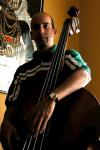
The Colors of Music / Los Colores de la Música
Mérida, Venezuela
September 21, around 3 p.m. local time
© 2008 Gerardo A. Sanchez, All Rights Reserved.
"One drama of my life consists of my telling people that I see colors whenever I hear music, and they see nothing, nothing at all, people don't believe me when I tell them, because they can't see the colors. For me, notes and tones express themselves in the form of colors. I am convinced that I could convey this to the public."
Oliver Messiaen.
Synesthesia is a neurologically-based phenomenon in which stimulation of one sensory or cognitive pathway leads to automatic, involuntary experiences in a second sensory or cognitive pathway. The interest in synesthesia is at least as old as Greek philosophy. One of the questions that the classic philosophers asked was if color (what we now call timbre) of music was a physical quality that could be quantified. The problem of finding a mathematical system to explain the connection between music and color has both inspired and frustrated artists and scientists throughout the ages. The seventeenth-century physicist Isaac Newton tried to solve the problem by assuming that musical tones and color tones have frequencies in common. He attempted to link sound oscillations to respective light waves. According to Newton, the distribution of white light in a spectrum of colors is analogous to the musical distribution of tones in an octave. So, he identified seven discrete light entities, that he then matched to the seven discrete notes of an octave (Taken from Wikipedia).
The big painter Wassily Kandinsky was very interested also in the music and color synesthesia. His recollection of the Wagner performance attests to how it had retrieved a vivid and complex network of emotions and memories from his past: "The violins, the deep tones of the basses, and especially the wind instruments at that time embodied for me all the power of that pre-nocturnal hour. I saw all my colors in my mind; they stood before my eyes. Wild, almost crazy lines were sketched in front of me."
Another basic elements of music that use color is to describe timbre instrument. Timbre describes all of the aspects of a musical sound that do not have anything to do with the sound's pitch, loudness, or length. Here you can see, in the main scene, a Violin with a very bright color, a Double-bass with a deep and dark color and the Piano a very "poly chromatic" instrument.
If you still are not convinced that this scene has to do with color, wait for the night and take a look into the small telescope, the colors of the stars will give you a very complex information about it... or just walk around and take a look to the paints on the wall, all them plenty of nice and bright colors...
Los colores de la música
"Uno de los grandes dramas de mi vida consiste en decirle a la gente que veo colores cuando escucho música, y ellos no ven nada, nada en absoluto. Eso es terrible. Y ellos no me creen. Cuando escucho música yo veo colores. Los acordes se expresan en términos de color para mí. Estoy convencido de que uno puede expresar esto al público."
Oliver Messiaen.
La sinestesia es la mezcla de impresiones de sentidos diferentes. Un sinestético puede, por ejemplo, oír colores, ver sonidos, y percibir sensaciones gustativas al tocar un objeto con una textura determinada. Uno de los procesos sinestésicos más frecuentes es cuando evocamos ciertas percepciones a través de nuestra visión y le asignamos un color. El gran pintor Kandisky, luego de escuchar Lohengrin de Richard Wagner, describía sus sensaciones de esta manera: "los violines, los contrabajos, y muy especialmente los instrumentos de viento personificaban entonces para mí toda la fuerza de las horas del crepúsculo. Mentalmente veía todos mis colores, los tenía ante mis ojos".
En música es frecuente también el uso de la palabra color para describir el timbre de un instrumento, una misma nota interpretada por instrumentos diferentes tendrá "colores" diferentes. Acá ven en primer plano tres instrumentos con colores muy diferentes: el violín con un sonido de colores brillantes, el contrabajo con su timbre oscuro y pesado y el piano instrumento de un "cromatismo" muy amplio. Atrás descansando, en el sofa, el cuatro (nuestro instrumento nacional), la guitarra y la flauta dulce.
Y si creen que esta escena no tiene nada que ver con el color, pueden esperar a que sea de noche para mirar una estrella por el pequeño telescopio, el color de esta les dará mucha información sobre su composición química y sobre su comportamiento en el universo... o también pueden pasear por nuestra galería donde verán algunas obras pictóricas, unas originales otras copias, pero sin duda todas ellas con un buen uso del color...
Lat: 8° 35' 2.55" N
Long: 72° 10' 35.96" W
Elevation: 1800 mts. over sea level
Precision is: Unknown / Undeclared.


 Tap or click the zoom icon in the bottom right corner of the picture to switch between in-page and fullscreen view
Tap or click the zoom icon in the bottom right corner of the picture to switch between in-page and fullscreen view